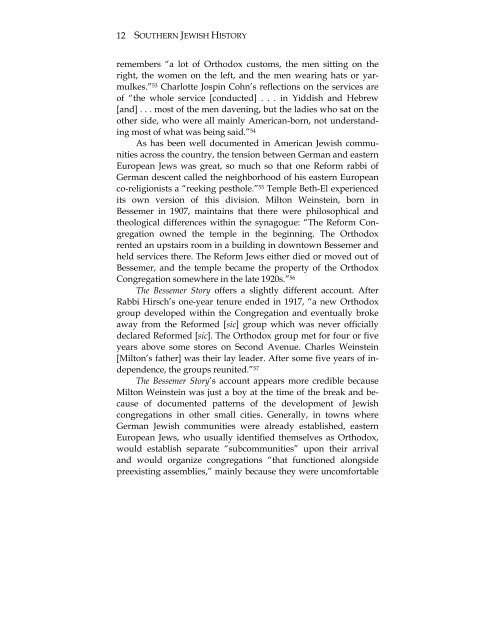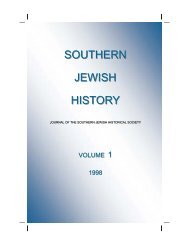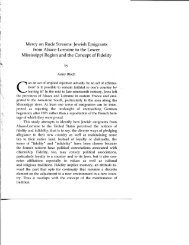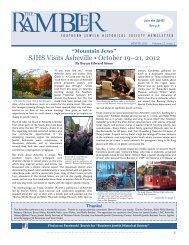A Shtetl Grew in Bessemer - Southern Jewish Historical Society
A Shtetl Grew in Bessemer - Southern Jewish Historical Society
A Shtetl Grew in Bessemer - Southern Jewish Historical Society
You also want an ePaper? Increase the reach of your titles
YUMPU automatically turns print PDFs into web optimized ePapers that Google loves.
12 SOUTHERN JEWISH HISTORY<br />
remembers “a lot of Orthodox customs, the men sitt<strong>in</strong>g on the<br />
right, the women on the left, and the men wear<strong>in</strong>g hats or yarmulkes.”<br />
53 Charlotte Josp<strong>in</strong> Cohn’s reflections on the services are<br />
of “the whole service [conducted] . . . <strong>in</strong> Yiddish and Hebrew<br />
[and] . . . most of the men daven<strong>in</strong>g, but the ladies who sat on the<br />
other side, who were all ma<strong>in</strong>ly American-born, not understand<strong>in</strong>g<br />
most of what was be<strong>in</strong>g said.” 54<br />
As has been well documented <strong>in</strong> American <strong>Jewish</strong> communities<br />
across the country, the tension between German and eastern<br />
European Jews was great, so much so that one Reform rabbi of<br />
German descent called the neighborhood of his eastern European<br />
co-religionists a “reek<strong>in</strong>g pesthole.” 55 Temple Beth-El experienced<br />
its own version of this division. Milton We<strong>in</strong>ste<strong>in</strong>, born <strong>in</strong><br />
<strong>Bessemer</strong> <strong>in</strong> 1907, ma<strong>in</strong>ta<strong>in</strong>s that there were philosophical and<br />
theological differences with<strong>in</strong> the synagogue: “The Reform Congregation<br />
owned the temple <strong>in</strong> the beg<strong>in</strong>n<strong>in</strong>g. The Orthodox<br />
rented an upstairs room <strong>in</strong> a build<strong>in</strong>g <strong>in</strong> downtown <strong>Bessemer</strong> and<br />
held services there. The Reform Jews either died or moved out of<br />
<strong>Bessemer</strong>, and the temple became the property of the Orthodox<br />
Congregation somewhere <strong>in</strong> the late 1920s.” 56<br />
The <strong>Bessemer</strong> Story offers a slightly different account. After<br />
Rabbi Hirsch’s one-year tenure ended <strong>in</strong> 1917, “a new Orthodox<br />
group developed with<strong>in</strong> the Congregation and eventually broke<br />
away from the Reformed [sic] group which was never officially<br />
declared Reformed [sic]. The Orthodox group met for four or five<br />
years above some stores on Second Avenue. Charles We<strong>in</strong>ste<strong>in</strong><br />
[Milton’s father] was their lay leader. After some five years of <strong>in</strong>dependence,<br />
the groups reunited.” 57<br />
The <strong>Bessemer</strong> Story’s account appears more credible because<br />
Milton We<strong>in</strong>ste<strong>in</strong> was just a boy at the time of the break and because<br />
of documented patterns of the development of <strong>Jewish</strong><br />
congregations <strong>in</strong> other small cities. Generally, <strong>in</strong> towns where<br />
German <strong>Jewish</strong> communities were already established, eastern<br />
European Jews, who usually identified themselves as Orthodox,<br />
would establish separate “subcommunities” upon their arrival<br />
and would organize congregations “that functioned alongside<br />
preexist<strong>in</strong>g assemblies,” ma<strong>in</strong>ly because they were uncomfortable







